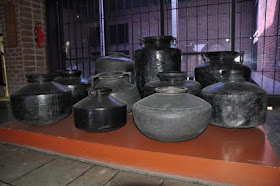 Bonfires, in preparation for the Holi celebrations, began to appear around the city today. The evening before Holi is Holika Dahan when bonfires burn to rid the place of the evil spirits. The ritual is a precursor to the mischievous and more commonly known festival of colour, where people take to covering each other in large quantities of wet and dry pigment.
Bonfires, in preparation for the Holi celebrations, began to appear around the city today. The evening before Holi is Holika Dahan when bonfires burn to rid the place of the evil spirits. The ritual is a precursor to the mischievous and more commonly known festival of colour, where people take to covering each other in large quantities of wet and dry pigment. The fires are situated, rather scarily, in the middle of throughfares around the narrow lanes of the Pols, close to houses, beneath telephone and electricity wires and in the middle of the roads!
The fires are situated, rather scarily, in the middle of throughfares around the narrow lanes of the Pols, close to houses, beneath telephone and electricity wires and in the middle of the roads! The people of the pol gather around the sites, talking and catching up.
The people of the pol gather around the sites, talking and catching up.
As the daylight fades, the fires are lit.

 Individuals walk around the fire an odd number of times (3, 5 or 7) pour water from small ritual jugs, give prayers or chant Mantras and make offerings, mostly of coconut or cereal (Wheat, Gram or oats).
Individuals walk around the fire an odd number of times (3, 5 or 7) pour water from small ritual jugs, give prayers or chant Mantras and make offerings, mostly of coconut or cereal (Wheat, Gram or oats).
 Watch a film of the Holi celebrations here: Celebrating Holi
Watch a film of the Holi celebrations here: Celebrating HoliThe ash from the fire will be collected and some placed on the body of individuals to protect from evil.
Learn more here: Holika Dahan
Learn more here: Holika Dahan































































